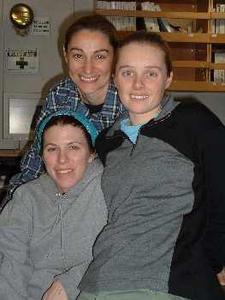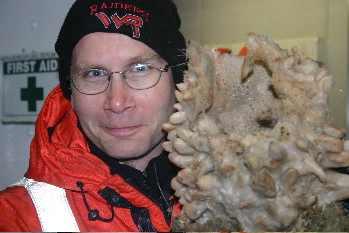11 February, 2004
The multichannel streamer was secured back on deck late last night.
After nearly six days of seismic work we would be heading south, back
toward Beaufort Island and with luck open water to continue the
multibeam survey. During the last hours of the seismic work, the
ship went through some heavy ice conditions and at one point the
streamer was pulled over some of the ice that had floated into the
wake behind the ship. No damage was done, and we were able to finish
the last of the planned shot lines.
By the start of the AM shift, the marine techs had already begun to
clean and disassemble the air guns. Each gun was taken apart, washed
in fresh water and laid out on cloth to dry. Parts of the guns are
made of dissimilar metals. When these are in contact with one
another in the presence of salts from the seawater and air, there can
be corrosive reactions with the metals that can ruin those parts of
the guns.
When the guns are reassembled, the marine techs lubricate the O-rings
that maintain the pressure in the firing chamber. After the guns are
put back together all opening that might allow dirt or water to enter
the working parts of the gun are sealed with duct tape. Jay Ardai,
Steve Ager and TJ Hurlburt took the guns apart making sure to keep
all the parts of one gun separated from another. The pile of parts
from each gun looks like a complex puzzle that they can put together
with great efficiency.
All the equipment on the ship is checked and maintained daily. The
smell of paint and cleaning solutions are always evident somewhere on
the ship. At the end of each shift change, and a crewmember and the
captain or mate do a walk through of the ship from the bridge to the
engine room. All main systems are checked. The new pilot on watch
waits for the mate's confirmation that all is OK and records the time
in the ship's log.
Inside and outside doors are lubricated and locks checked to see if
they work properly. The crew is constantly finishing one task and
moving to the next. It is hard to believe that the Palmer is over
tem years old. It is so well maintained it still looks new. Even
with all this attention to detail, sometimes things break. During
dredge #5 the main bucket on the dredge broke completely off. When
the dredge was brought on deck all that came aboard was the metal A
frame and the winch cable. There was no indication from the winch
room that the tension on the cable had been too high. It may have
hit something as it was dragged across the seafloor that caused it to
break. No one was sure how or why it broke, but there was plenty of
speculation. Pictures of the broken dredge were taken, jokes shared
and then Jesse Doran and Jenny White prepared the backup dredge for
try number two.
The second try was a huge success. There were dozens of large rocks
and there was no mud or sediment. Sam Mukasa was pleased with his
catch. All the rocks were carried to the wet lab where the Sam
washed each one and set it out to dry. In addition to a nice cache
of rocks, there was an abundance of organisms. The largest was a
sponge over 12 inches in length and 7 inches across. Brittle stars
and other small echinoderms were in abundance.
It was a very successful afternoon. We headed toward the ice. The
wind from earlier in the week had cleared out areas that had be ice
covered earlier and we were unable to do multibeam work. We would
target that area for the evening and the start of tomorrow.
Who's Who?
Cristina Millan (Martinez) - OSU - From Madrid, Spain and is a
graduate student working toward a PhD in Geology. Research interests
are mineralogy and structural geology. Her thesis is on economic
geology. She has two children 14 and 10 years old. Interests are
geology, field research, and reading, being stuck on a ship. She
enjoys sewing, the outdoors and raveling. She works with Terry
Wilson on a variety of geology projects being conducted in
Antarctica. She has been married for 15 years and living in the US
14 years. Her husband Richard has been the most supportive person
helping to make her dreams for a career in geology a reality.
Richard is a chemical engineer and works as a project manager for
Battelle. She wants women to know that it are definitely is possible
to combine a successful career, raise a family and pursue an advanced
degree.
Joanne Whittaker - Graduate Student, Wellington, NZ
Jennifer Nice - University of Texas, Dallas - 21 year old from
Dallas, TX. She just received a BS in Geosciences from the University
of Texas at Dallas in December. She is in Antarctica taking the
semester off to decide what to do for her masters that she will start
in the fall. This is her first trip south of the equator and likely
the first time in negative temperatures.
She like the outdoors, camping and road trips. She doesn't understand
why no one else on this cruise likes fried pickles. She will be
getting married just a few weeks after returning from Antarctica.
She has an older sister who is a teacher, her mom is a nurse and her
dad is an amazing person who pulls trees out of the ground in his
spare time.

Jennifer Nice, Cristina Millan, and Joanne Whittaker from the night shift.

Steve Ader, Jay Ardai and TJ Hurlburt disassemble and clean the air guns.

Mr. Stevenoski with a large sponge caught in the dredge.

Contact the TEA in the field at
.
If you cannot connect through your browser, copy the
TEA's e-mail address in the "To:" line of
your favorite e-mail package.
|
